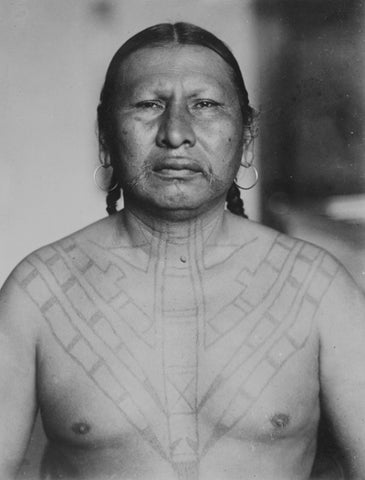Tattoos have been a part of human culture for thousands of years, and among Native American peoples, they have a rich and varied history that spans thousands of years. In many tribes, tattoos were used for a variety of purposes, including spiritual and cultural beliefs, tribal identification, and personal expression. In this article, we'll take a closer look at the history of tattoos among Native American peoples and explore some of the different cultural and spiritual meanings associated with this timeless art form.
One of the earliest forms of tattooing among Native Americans was the practice of scarification, which involved cutting or burning the skin to create permanent markings. This practice was used for both practical and spiritual purposes, such as indicating that an individual had undergone a significant life event or spiritual rite of passage. For instance, some tribes would mark the faces of warriors with scars to commemorate their bravery in battle, or the bodies of women who had undergone a significant life event such as childbirth.

Tattoos also played a role in tribal identity and were used to distinguish members of different tribes from one another. For example, some tribes would tattoo unique symbols or designs on their faces or bodies to signify their membership in the tribe. These tattoos were often highly individualized and reflected the wearer's personal beliefs and experiences. For instance, a Native American man might have a tattoo of a bear to symbolize his strength and courage, or a woman might have a tattoo of a eagle to represent her connection to the spirit world and her ability to see beyond the physical realm.
Another common use of tattoos among Native American peoples was to honor and pay tribute to their ancestors. For instance, tattoos of animals and other natural elements were used to represent the wearer's connection to the spiritual world and their belief in the interconnectedness of all living things. These tattoos served as a reminder of the wearer's spiritual roots and helped to connect them to their ancestral heritage. For example, the Apache tribe believed that a tattoo of a bear represented the strength and wisdom of the animal, and served as a reminder to the wearer to be brave and to respect their elders.
Tattoos were also used for spiritual and healing purposes, and were believed to have powerful spiritual properties. For example, some tribes would tattoo the bodies of healers with symbols and designs associated with healing, such as the sun or the moon, to enhance their ability to heal the sick. In some cases, tattoos were also used to ward off evil spirits and protect the wearer from harm.
Despite their long history and cultural significance, tattoos were largely banned or discouraged among Native American peoples during the colonization and reservation periods. This was due, in part, to the influence of Christian missionaries who saw tattoos as "heathen" and sought to suppress native cultural practices. Many Native Americans were forced to abandon their traditional beliefs and practices, and tattoos became a symbol of resistance and defiance against the cultural oppression they faced.

However, in recent years, there has been a resurgence of interest in traditional Native American tattoos, and many people are reclaiming the art form as a way to connect with their cultural heritage and traditions. Today, tattoos continue to play a significant role in Native American culture, and are seen as a way to preserve and celebrate their rich history and traditions.
One of the most interesting things about Native American tattoos is the wide variety of cultural and spiritual meanings associated with different symbols and designs. For instance, the symbol of the bear is widely associated with strength and courage, and is often used to honor warriors and other brave individuals. The eagle is another common symbol in Native American tattooing, and is often used to represent spiritual awareness, freedom, and the ability to see beyond the physical realm.
The wolf is another popular symbol in Native American tattoos, and is often used to represent loyalty, strength, and the ability to adapt to change. In many tribes, the wolf is seen as a powerful spirit guide, and a tattoo of a wolf is believed to bring good fortune and protection to the wearer.
The dreamcatcher is another common design in Native American tattoos, and is often used to symbolize the importance of dreams and the protection of the dreamer. In some tribes, dreamcatchers were made from natural materials such as feathers and beads and were used to filter out bad dreams and allow only positive and uplifting dreams to reach the dreamer. A tattoo of a dreamcatcher is believed to bring good dreams and peace of mind to the wearer.
Another common design in Native American tattoos is the medicine wheel, which is a symbol of balance and harmony in life. The medicine wheel is often associated with the four cardinal directions, and each direction is associated with a different color, element, and spiritual meaning. A tattoo of a medicine wheel is believed to bring balance and harmony to the wearer's life, and to help them connect with the spiritual world.
In conclusion, tattoos have been an important part of Native American culture for thousands of years, and have a rich and varied history that spans different tribes and traditions. From marking significant life events and tribal identity, to honoring ancestors and spiritual beliefs, tattoos have played a significant role in Native American culture and continue to do so today. Whether you are looking to connect with your cultural heritage or simply want to pay tribute to the rich history of Native American tattoos, there is a design out there that is sure to speak to you.
Want a painless tattoo? Consider using TKTX numbing cream, find it out here


